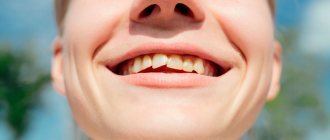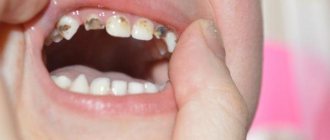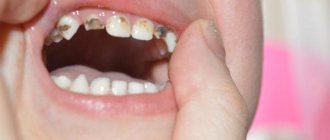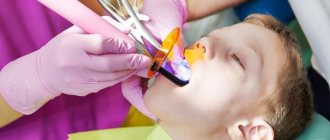From this article you will learn:
- how many baby teeth does a person have,
- How are temporary teeth different from permanent teeth?
- Scheme of loss of baby teeth in children.
Milk teeth are a set of twenty temporary teeth that begin to erupt in a child, usually at the age of 5-6 months (the central incisors of the lower jaw erupt first). The need for temporary teeth is evolutionarily determined by the small size of the jaws of newborns. Permanent teeth are much larger than milk teeth, and their number is 1.5 times greater, and therefore, if children immediately had permanent teeth, they simply would not be able to fit into small jaws.
Because of this, in small jaws, smaller temporary teeth (in a reduced number) erupt first, and only when the jaws reach the desired size does the child replace milk teeth with permanent ones. Therefore, the time when baby teeth fall out in children is integrally connected with the growth of the jaw bones and the development of the rudiments of permanent teeth. Typically, the loss of primary teeth begins in children at the age of 6 years, and in girls this process begins earlier and proceeds faster.
In Fig. 2 you can see how the change of baby teeth to permanent ones in children looks like on an x-ray. In this case, we see that the child has already erupted permanent central and lateral incisors, as well as the first permanent molars. But in the lateral sections of the jaws we also see still preserved milk teeth, between the roots of which the rudiments of permanent teeth are located.
Temporary teeth
Timing of teething
Dental buds are formed during the period of intrauterine development. The eruption of the first teeth begins at the twenty-fifth week of the baby’s life. The lower incisors appear first, followed by the upper ones by eight months. The age at which baby teeth, called premolars, erupt varies from one to two years. The last to appear are the canines and second premolars, which occurs from sixteen to thirty months.
This teething schedule is optimal, but it is impossible to determine the exact timing. The process depends on the characteristics of the child’s body, the health of the mother during pregnancy and genetic factors.
Timing of teething in children in the table
| Type of tooth | Lower jaw | Upper jaw |
| Medial incisor | 6 – 10 months | 7 – 12 months |
| Lateral incisor | 7 – 16 months | 9 – 13 months |
| Fang | 16 – 23 months | 16 – 22 months |
| First premolar (baby molar) | 12 – 18 months | 13 – 19 months |
| Second premolar (baby molar) | 20 – 31 months | 25 – 33 months |
The order of teething in children
The teeth follow the principle of pairing, for example, if one fang appears, a second one should be expected soon. The sequence of teething is determined by nature based on the practical significance of dental units for survival.
The front teeth of the lower row grow first, then the upper ones come. The lateral incisors disrupt the order of teeth eruption; their appearance begins with the upper jaw. Then comes the eruption of chewing teeth - the first premolars. The last to emerge are the canines and molars. The process of teething in children is completed by the age of 2-3 years.
Diagram of baby teeth eruption in children
Typical problems.
The most typical problem between the ages of 3 and 6 years is the development of caries of primary teeth in the area of the first and second primary molars. The narrow interdental spaces between the first and second primary molars, which are difficult for a child to reach, are an ideal place for plaque to accumulate. As a result, caries forms on the surface of the teeth hidden from the eyes of parents (between the 4th and 5th milk teeth). Being unnoticed, the carious process quickly progresses, complicated by inflammation of the nerve of the tooth (pulpitis).
With poor oral hygiene and a large number of carious teeth, caries of the permanent molar (6th tooth) often develops, high-quality treatment of which is only possible by a pediatric dentist.
Permanent teeth
Timing of teething in children
The first permanent teeth appear several months before the baby teeth fall out—the molars, or “sixes,” erupt. This occurs at the age of six. By the age of eight or nine years, it is the turn of the incisors. When a child is ten to twelve years old, premolars and canines erupt. Next come the second molars, the eruption of molars is completed by adulthood.
Important!
Wisdom teeth appear much later, after twenty years. However, their complete absence is also the norm.
Timing of teething in the table
| Name | Lower jaw - time of eruption | Upper jaw - eruption time |
| Medial incisor | 6 - 7 years | 7 - 8 years |
| Lateral incisor | 7 - 8 years | 8 - 9 years |
| Fang | 9 - 10 years | 11 - 12 years |
| First premolar | 10 - 12 years | 10 - 11 years |
| Second premolar | 11 - 12 years | 11 - 12 years |
| First molar | 6 - 7 years | 6 - 7 years |
| Second molar | 11 – 13 years | 12 - 13 years old |
| Third molar | 17 – 21 years old | 17 – 21 years old |
Teething order
The pairing principle also applies to permanent dental units. The correct sequence of teething is important for the formation of the bite; it is necessary to carefully monitor the time of loss of baby teeth and the order of growth of molars.
The lower molars appear first, then the upper ones. Next, the temporary teeth of the lower jaw fall out, the permanent teeth erupt, and only then the upper dental units are replaced.
This schedule for teething in children is not universal, but if there are significant deviations, you should consult a specialist.
Causes for concern
When a child remains without teeth after turning one year old, parents should take him to the doctor. Of course, the time at which chewing organs appear may vary. For example, in boys this process occurs more slowly than in girls. But, there are situations when medical consultation is absolutely necessary.
- An urgent visit to a pediatrician is necessary at a high temperature of more than 39 degrees.
- The baby should be shown to a doctor if symptoms such as frequent diarrhea and vomiting develop.
- An orthodontist is consulted if a malocclusion is suspected. Perhaps, after the eruption of incisors, canines, and molars, he needs therapy. In such situations, braces are used for children while the jaw apparatus is pliable.
- A specialist should examine a newborn whose units appeared in the prenatal period.
- A dentist is consulted if the organs are not formed in the dentition.
Therapy may consist of strengthening the health of the toddler, performing special exercises, and massaging the gums.
Signs of teething
Symptoms of teething in infants
The appearance of baby teeth is a little more difficult than that of permanent teeth, since the baby has not yet encountered pain and cannot understand what is happening to him. Teething in children under one year of age is accompanied by the following signs.
- The most common symptom of teething is fever. An increase to 38 degrees within three days is normal.
- Swelling of the gums. Often, when children are teething, their gums swell, their sockets itch, and they have a desire to chew hard objects. It is important to prevent the child from damaging the mucous membrane; it is better to buy a special teether to relieve discomfort.
- Decreased appetite. Children refuse to eat due to stress or itchy gums.
- Teething syndrome. Neurosis, tearfulness, anxiety, poor sleep and whims may indicate the imminent appearance of the first tooth, even if the child does not experience pain, fever or swelling of the gums.
Important!
An increase in white blood cell levels during teething should not be a cause for alarm. This is a common occurrence associated with a weakened immune system.
Symptoms of eruption of permanent teeth
A change in temporary bite is accompanied by other unpleasant sensations. The process has the following characteristics.
- Root resorption and loss of baby teeth. A sure signal of the appearance of a new tooth in the coming months.
- Increase in jaw bone size. Permanent teeth are larger than baby teeth, the jaw grows, creating conditions for a change in bite.
- Pain in the gums. Redness and swelling of the mucous membrane are a reaction to teething.
Important!
Body temperature above 38 degrees, cramps, refusal to eat and difficulty breathing are not symptoms of the appearance of milk and permanent teeth. These are signs of an infectious disease. It is necessary to urgently consult a doctor.
Location and anatomical features of molars
Since man is an omnivore, for a healthy metabolism he needs different foods, including rough, animal, and plant foods. In order for the body to absorb it, you need to chew the food well, which is what molars do. Their chewing area reaches 1 cm2. Each such organ can withstand pressure of up to 70-75 kilograms. In total, there are up to 12 such units in the oral cavity of an adult. Six of them are located on the lower jaw, six on the upper jaw, three on each side.
The last elements in the series are the third molars. They are also called wisdom teeth. They cut through in adults, and often may not cut through at all. Their roots can have two, three or more branches. The size of the crowns of molar units can reach from 7 millimeters, in some organs up to nine. Their chewing surface is diamond-shaped with rounded corners. It has four tubercles, which are separated by 3 grooves located transversely. Classification of roots:
- palatal;
- buccal-distal;
- buccal-mesial;
The last type of roots is the largest. The palatine root belongs to the middle ones. The shortest in size is the buccal-distal. Each subsequent molar unit is endowed with smaller roots and a crown portion than the previous one. The first molar organs are large, their coronal surface is significant in area, and the size of the roots is the largest. The second units are already smaller in size. The extreme units do not have milk precursors. Their root length and crown size vary significantly. Usually, there are 3 tubercles on the crown, one of which is lingual and 2 buccal. As a rule, their roots are not too long, but they are often displaced and deviated to the side. Wise teeth can come into contact with 2 antagonists at the same time. This is considered normal.
On the upper jaw
The top row has its own characteristics and differences. Their main aspect is location. They form a straight line that is only slightly curved and diverges to the sides. The slope of the units increases from the first to the third segment. In addition, in the upper teeth:
- Larger in size than the organs located in the lower jaw;
- The root system is more powerful, it has three roots;
- The tooth surface area is extensive;
- Good ability to chop and chew food;
- The outer side is covered with sharp tubercles with protruding forms, there are 3 or more of them;
The second molars of the upper row in the coronal part are similar to the first molar units, although they are more massive and rectangular. They are easier to dissect. The roots are usually grouped, sometimes merging with each other. The canals, which are parallel, often overlap each other when X-rays are taken. The roots are shorter compared to previous teeth. The three mouths often form a flat triangle, less often a straight line. The convex bottom of the chamber gives the mouths a funnel shape. It happens that the channels to the bottom of the chamber bend at a very acute angle.
Rarely do the upper posterior units have four roots. The first molar large organ of the upper jaw is equipped with more powerful roots than its lower antagonist. The peculiarity of the second molar teeth is that their crown can have any shape, while the lower ones can only have a certain shape. Properties of the shape of the upper units: cubic, regular, with a clear cross-shaped groove that divides the surface into four parts. The eights that are located on top are smaller in size than the bottom ones. In addition, they can develop from 1 to 4 or more roots.
On the lower jaw
Molars on the chewing side have tubercles, as well as fissures, that is, grooves. They can be shaped like cones, drops, or grooves. Reliefs are formed during the formation of organ rudiments. Since they grind food, there is a high risk of caries. To avoid such a pathology, it is necessary to seal the fissures. The procedure prevents food particles from getting into the grooves. In addition, sealants nourish the enamel layer with fluoride, helping it become healthier. To achieve maximum effectiveness, the session is carried out immediately when the units erupt, or within 12 months.
The molar organs of the lower row differ from the segments of the upper jaw. Their features:
- Such units have a different anatomical structure.
- They most often have 3 canals and 2 roots.
- They are smaller in size than their antagonists.
- The number of tubercles varies from three to six.
- The distal and medial roots are parallel.
- Root fusion is often diagnosed.
- The crown of the first unit has the shape of a cube, it is slightly elongated in the direction of the dentition.
- The most posterior wise crowns are always large in size, they are larger than the upper ones.
- As a rule, they have two roots that can grow together into one.
- The fissure tubercles are lower, blunt, and have a rounded shape.
The bottom row is located almost in a straight line. The crowns are inclined in the opposite direction than on the upper segment. Because of this, when the jaw bones are closed, the upper row is superimposed on the units of the lower jaw with a slight shift outward. The crowns of the 2nd molar tooth are slightly smaller than the coronal part of the first unit. The approximal surfaces are located almost parallel. They taper slightly at the neck. The vestibular surface is divided into 2 parts by a rather deep notch.
Painful teething: advice for parents
When faced with teething in children, many parents are at a loss. First of all, you need to call an ambulance and determine the reason for the baby’s poor health. If symptoms are confirmed, the specialist will prescribe medications for teething - antipyretics and painkillers.
You can treat your gums yourself with an anesthetic gel with a cooling effect to reduce itching and swelling of the mucous membrane. Ice will also help. To reduce gum irritation, there are special silicone fingertips made of hypoallergenic material.
Folk remedies for teething will effectively relieve painful sensations - a decoction of chamomile, sage, tincture of valerian and honey will soothe inflamed tissues.
Painkillers for teething are contraindicated in children; this can worsen their health.
Important!
Without a doctor's recommendation, antibiotics and other strong teething medications can cause an allergic reaction.
What should mom do?
When teeth erupt out of order, every parent should take this fact seriously. Pediatricians advise feeding your baby in a balanced manner. For six-month-old children, mother's milk is not enough. Complementary foods should be introduced gradually. Mothers should properly allocate time for wakefulness and sleep, and visit the doctor according to the schedule. A vitamin complex may be prescribed. It is prohibited to select medications on your own, since only a doctor can give an objective assessment of the baby’s condition.
If the chewing organs do not appear according to the calendar, specialists prescribe certain tests to determine the cause of the failure. Mom should not neglect the doctor's recommendations. Its instructions should be followed exactly to stimulate the appearance of units. To do this you need:
- Include foods rich in vitamins in your diet;
- Correctly create a daily routine and monitor its implementation;
- Conduct comprehensive physical exercises with children;
- Regularly visit a doctor for preventive purposes;
- Treat illnesses in a timely manner;
Taking medications without a doctor's recommendation is dangerous and detrimental to a child's health. Only care and affection, proper care and feeding will allow you to raise a healthy child.
Deviations in teething
Minor changes in the timing and sequence of dental growth should not cause alarm. However, significant deviations from the norm in teething are a cause for concern.
- The tooth does not appear for a long time. Reason: genetic predisposition to long eruption or lack of rudiments.
- Too early appearance of teeth. Caused by disruption of the endocrine system.
- Black or brown enamel surface color. Indicates high iron levels, poor salivation, or chronic inflammatory processes in the child’s body.
- Incorrect row position. Bite pathologies indicate a hereditary factor or deformation of the maxillofacial bone.










